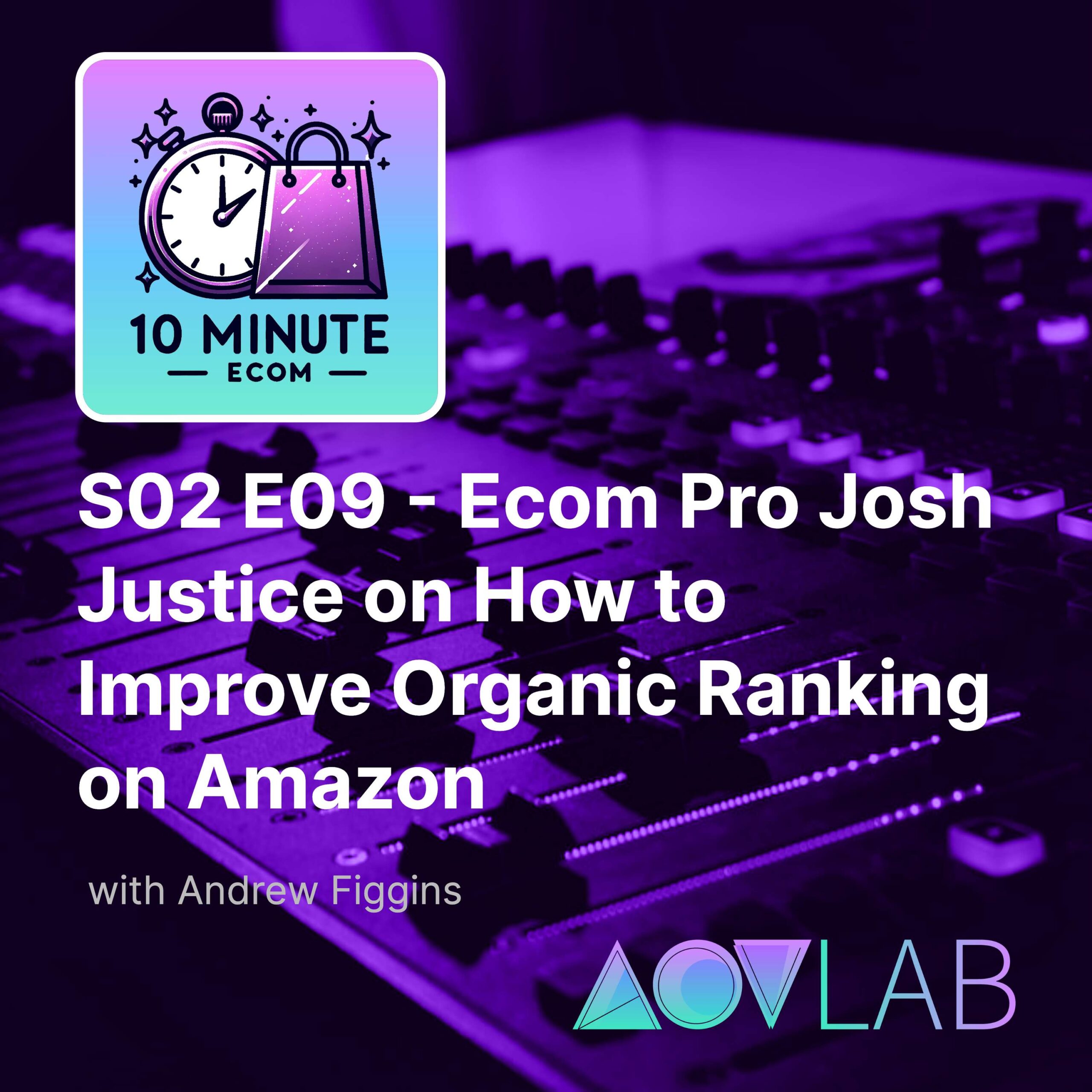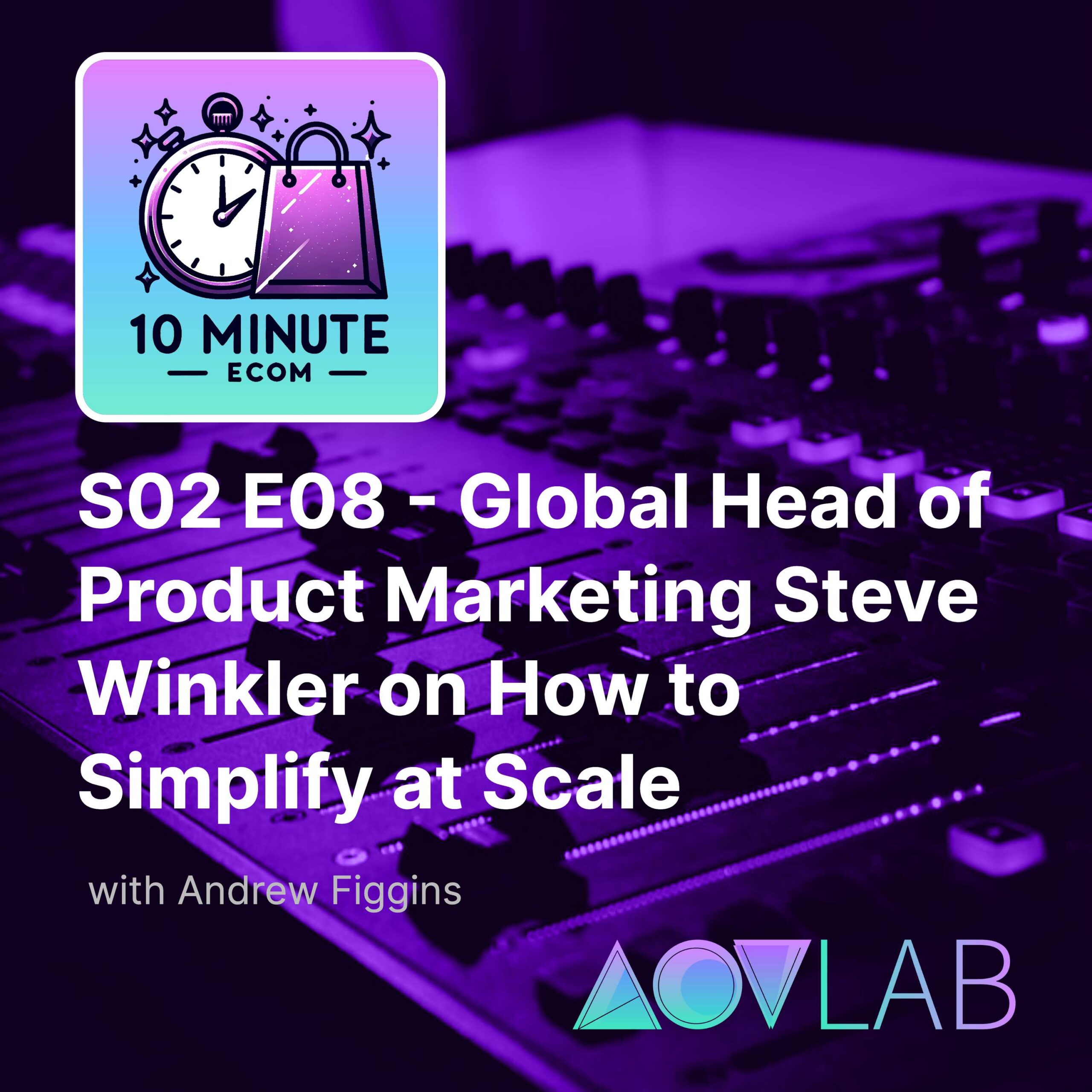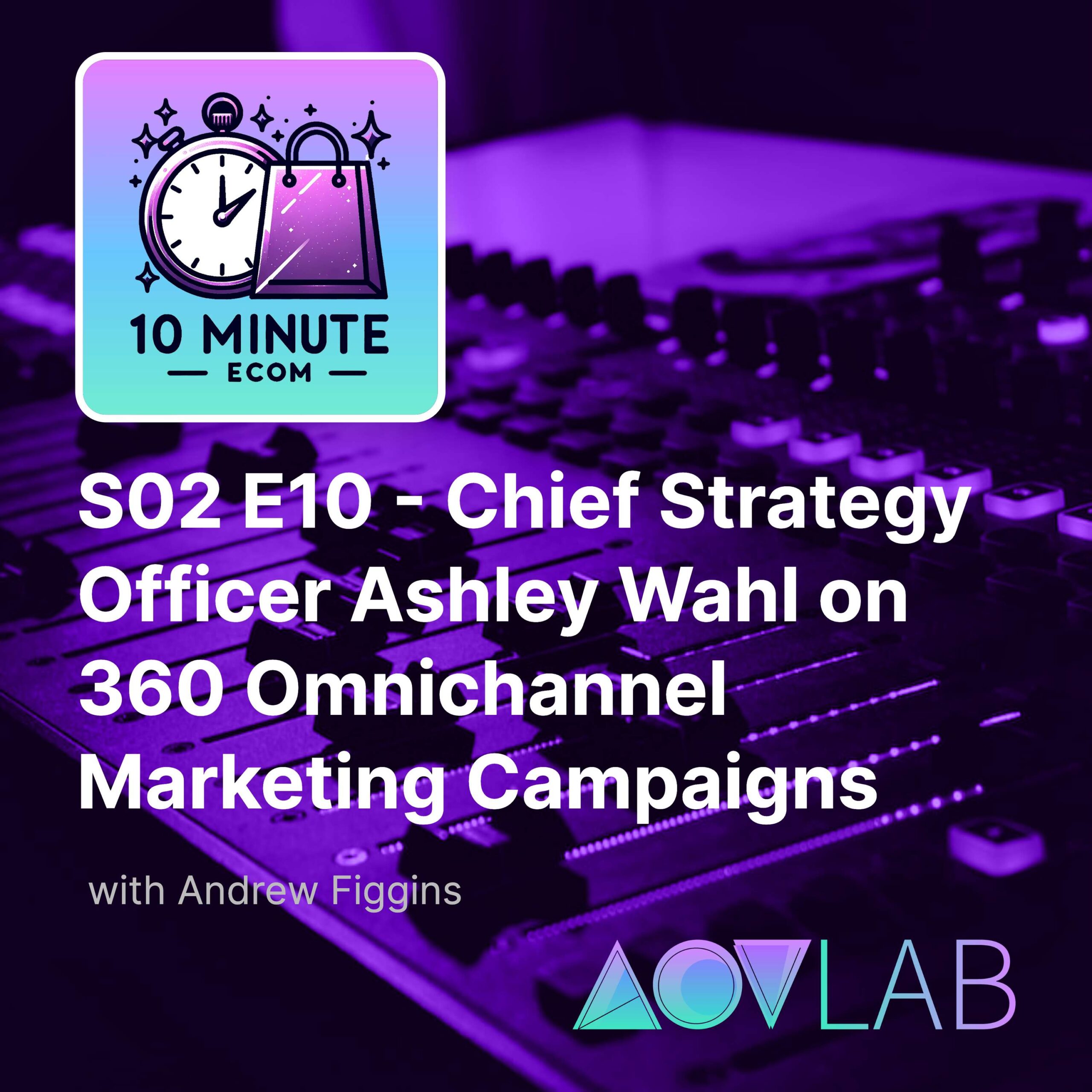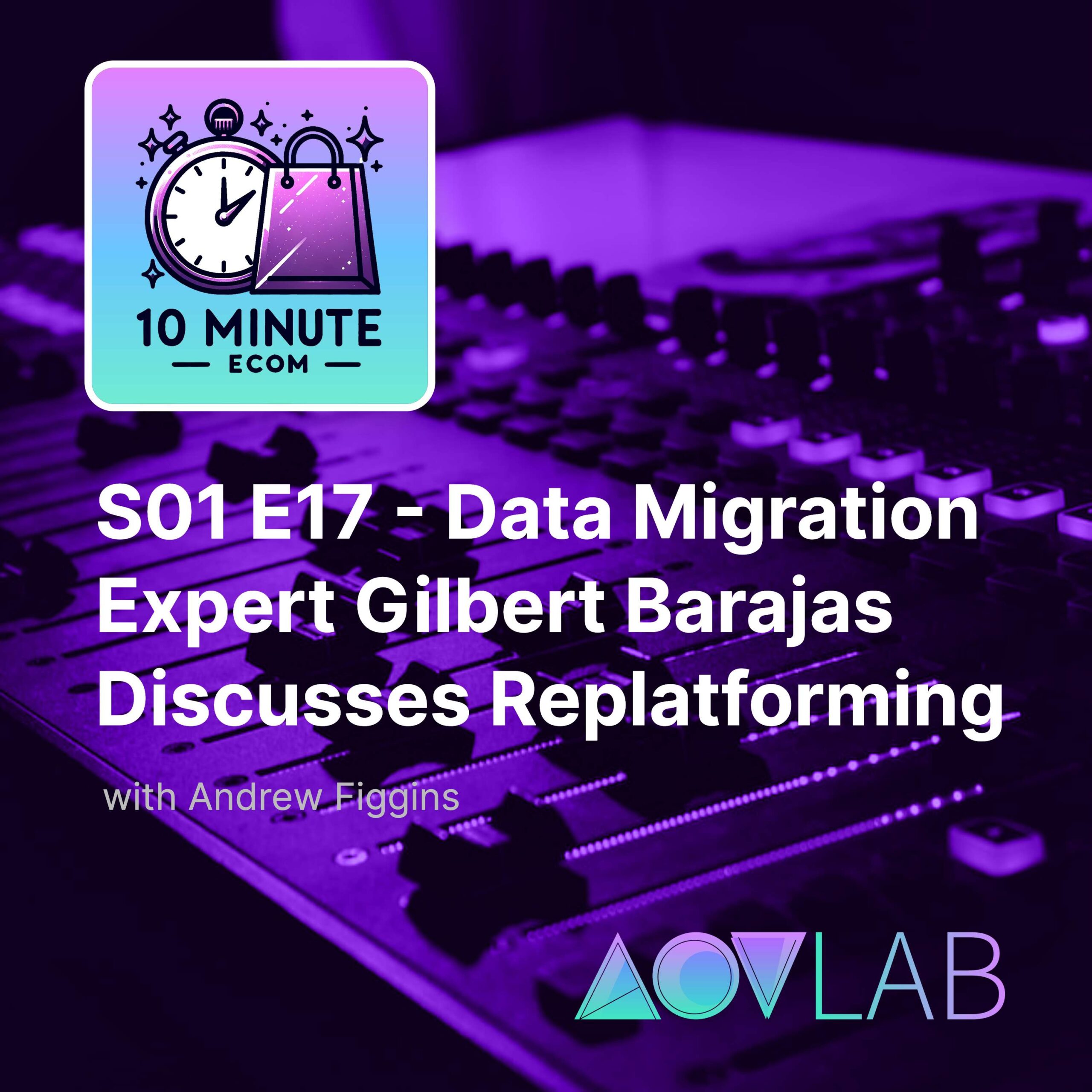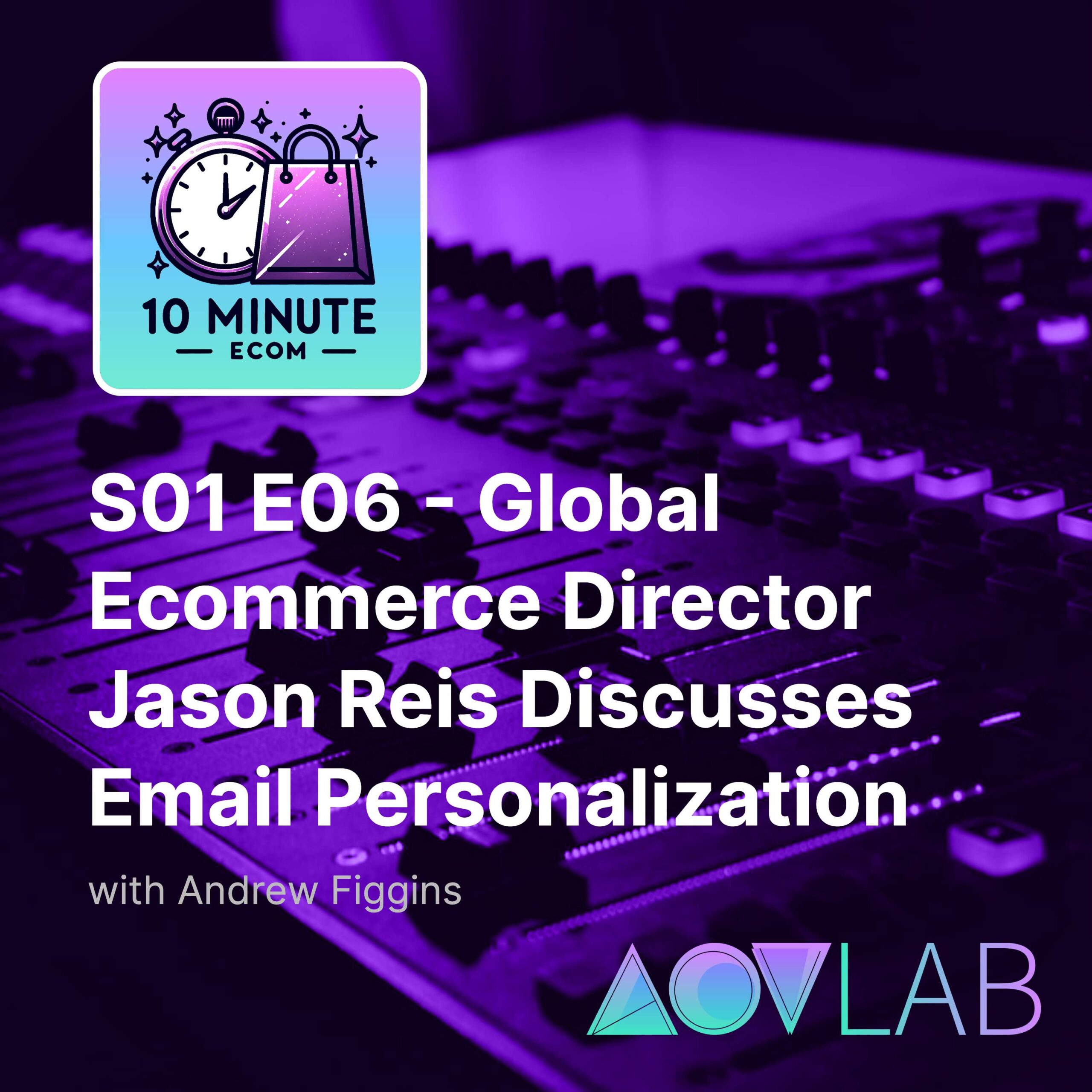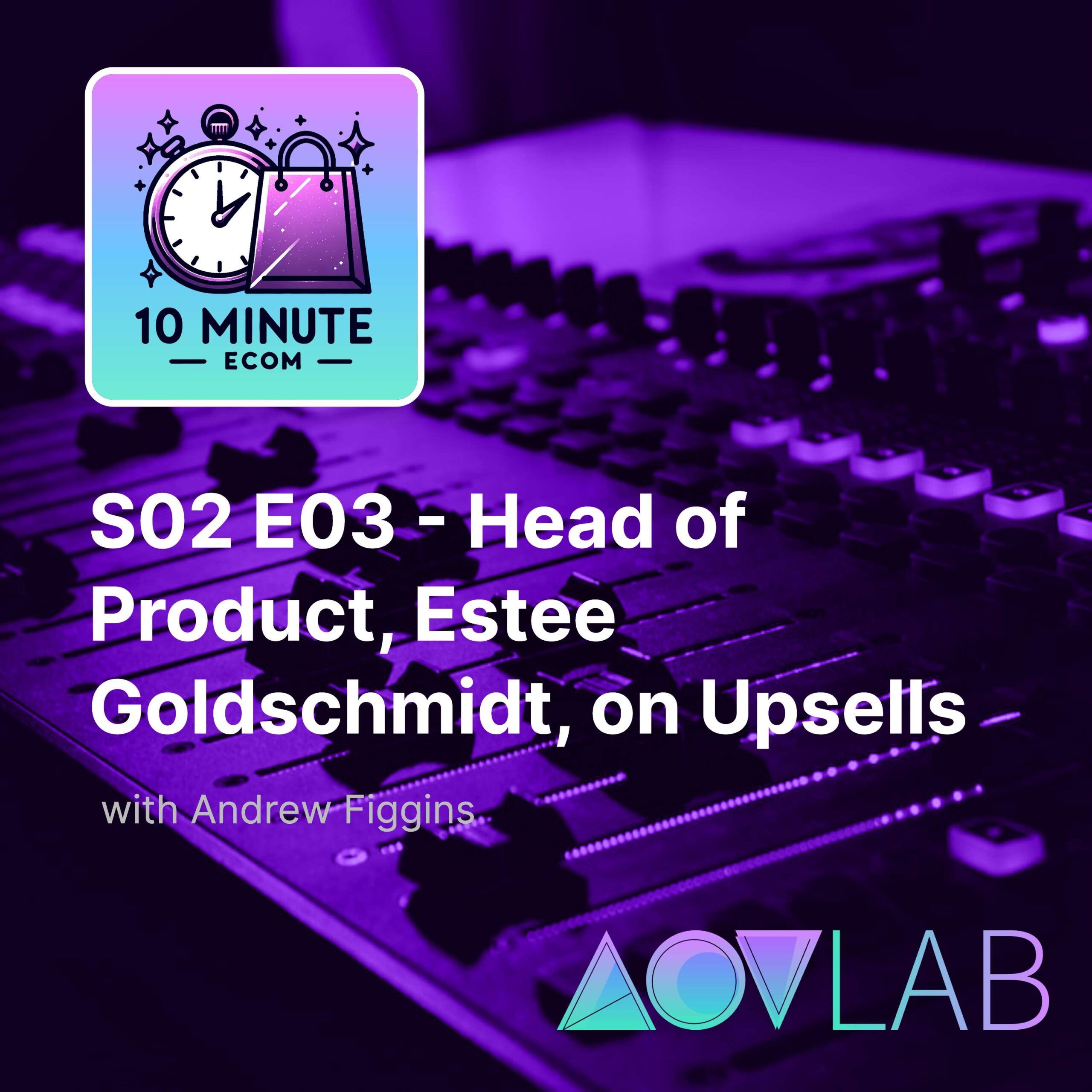View Full Transcript
Episode Transcript
[00:00:07] Speaker A: Hello, ecommerce fans, and welcome to ten minute Ecom and AOV Lab podcast. Every episode we break down a new and different tactic that can help you improve your ecommerce KPIs key performance indicators. I'm your host, Andrew Figgins. I am an ecommerce professional. You may know me as the founder of AOV Lab. Webb, the former vp of product innovation at Scrubs and beyond, or is the former director of ecommerce technology at Rural King.
Today I'm excited to be talking to.
[00:00:35] Speaker B: Josh justice, an e commerce colleague that.
[00:00:38] Speaker A: Is doing very interesting work in e commerce and has a lot to say today on this episode that's very informative, so be sure to stay tuned for the entire episode.
[00:00:47] Speaker B: Anyway, Josh, what did you come on.
[00:00:49] Speaker A: The show to share today with your e commerce colleagues?
[00:00:52] Speaker C: Hi, I'm Josh and I'm from Super ATV based South California.
[00:00:56] Speaker D: One thing I've seen that works in.
[00:00:58] Speaker C: Ecommerce is having specific advertising campaigns that helps not only sell your products, but helps them improve their organic ranking and improve sales overall.
[00:01:07] Speaker B: Thank you, Josh.
[00:01:09] Speaker A: After the ad, we'll get right into the chat. Today's episode of ten minute Ecom is brought to you by shop aov lablab.com. It is a brand new store with fun apparel and gear specifically for Ecom professionals just like you and me. We've got high quality embroidered and printed t shirts, hoodies and hats that will spice up any Zoom call or in person meeting with your team. If you lead a team, these products.
[00:01:34] Speaker B: Make for awesome gifts to celebrate hitting.
[00:01:37] Speaker A: A conversion rate or average order value milestone. If you work in ecommerce, I think you'll not only find some humor in these products, but also a sense of pride for what you do every day. Again, the site is shop AOV lab. Head over right now and browse while you listen. Unless you're driving. In that case, pull over. You've got to see and share these.
[00:02:00] Speaker B: Products one last time. The website is shop aov lablab.com.
And now back to the show.
Josh, it's a pleasure to have you here today on ten minute Ecom. I'm super excited to dive in and talk about this. Some of this is very new to me. So can you explain the difference between what you're talking about and the more traditional approach to advertising marketplaces?
[00:02:27] Speaker C: Definitely. So overall, the goal of advertising on Amazon is that you want more sales, and you typically have a roas goal.
[00:02:34] Speaker D: Or an eight cost goal.
[00:02:36] Speaker C: You might want a two or three.
[00:02:37] Speaker D: Row, as if the category is super.
[00:02:38] Speaker C: Competitive or you're trying to shoot for a five to eight because you don't.
[00:02:42] Speaker D: Have a lot of money. So there's, the other side is like.
[00:02:45] Speaker C: You want to be efficient, but you also want to use advertising to help get your products ranking higher organically, so you spend less advertising on them long term and you can grow the business in a competitive market.
[00:02:58] Speaker B: That makes a lot of sense to me. Tell me a little bit. We were chatting about this before the recording started today, being able to isolate your branded versus your more generic searches or your non branded searches. Can you talk about that a little bit?
[00:03:12] Speaker D: Yeah, so I would say I could.
[00:03:14] Speaker C: Talk about that second, or let's just give an example of unbranded versus branded.
[00:03:20] Speaker D: So you definitely want to isolate campaigns.
[00:03:22] Speaker C: And keywords into unbranded and branded campaigns. Unbranded being the generic words. Like, if you're looking for a toy at Christmas, you might be typing in toys for boys age five or whatever, or toys, or you might just have some generic.
[00:03:38] Speaker D: There's no brand involved and you're competing.
[00:03:40] Speaker C: Against everyone and their mom on Amazon. So it's super competitive. Whereas if you are typing in, I'm looking for a GI Joe, that's a name brand.
So you want to keep those separated because the intentions to purchase is different. If you're looking for GI Joe or.
[00:03:57] Speaker D: A Lego set, you're highly likely to.
[00:04:00] Speaker C: Buy what you're looking for, especially because Amazon has such a wide variety. So your row as on that is going to be 15, $20. It's going to be high compared to.
[00:04:09] Speaker D: If you're bidding on toys for boys age five, there's a lot of competition. Your rows of a three or four.
[00:04:16] Speaker C: Is going to be pretty.
[00:04:17] Speaker D: So you want to isolate those so.
[00:04:19] Speaker C: That you're efficient with your money that you're spending and you can measure things properly.
[00:04:24] Speaker B: I definitely come from a background of like roas being the lighthouse metric in terms of advertising on marketplaces or even Google. But I think what you're saying today in this topic that you're bringing up, the tactic that you're bringing is really Roas is not the most important thing. Sounds like something else is more important. What is that?
[00:04:46] Speaker D: Yeah, I would say that in general.
[00:04:48] Speaker C: I try to have a good role as overall for an account, but within the account you can have different goals for different kinds of ads. And so that's where we talk about.
[00:04:57] Speaker D: If you have a rose of like 0.5 or just a dollar, but it's.
[00:05:02] Speaker C: Increasing your sales by 50% or it's.
[00:05:05] Speaker D: Increased by sales, organic sales, then you look at it as a marketing cost or an operating expense.
[00:05:13] Speaker C: Yeah, of course, I would spend that money to get, overall a lot more sales. And so this is something that is.
[00:05:19] Speaker D: A little bit more. It's definitely widely more accepted than it.
[00:05:23] Speaker C: Was maybe a few years ago. And I've had some examples of some success.
[00:05:27] Speaker D: And I think in this environment, I.
[00:05:30] Speaker C: Think I know in this environment, a lot of people, you have a limited budget, right. You're not going to easily get money. And so it's really important to also keep track of how you're spending money because it's easy to just not dig in deep and there's times to dig in deep and times to not be too worried about your advertising, but, yeah.
[00:05:46] Speaker D: So goal is overall to increase sales. So that's the topic for today.
[00:05:50] Speaker B: Absolutely. Josh, I'm curious, how do you separate the products and choose one for the more organic strategy versus the paid strategy that then lifts up all organic? How do you make those choices?
[00:06:04] Speaker C: Yeah, so typically it's not chosen by the advertiser unless if I'm in an advertising role, I'm going to let my key account manager or my director know. So really, that's like a company objective, right? Hey, we want to prioritize these products, get people into our brand and purchasing some of our other products.
[00:06:20] Speaker D: So you typically should already have a.
[00:06:22] Speaker C: Priority list where you want to tier it and have a top five list, top ten or top 13 and break it up.
[00:06:31] Speaker D: So that's where you start. So let's say I can give you.
[00:06:35] Speaker C: An example of when I worked at.
[00:06:36] Speaker D: Lego, I had four products that were.
[00:06:39] Speaker C: For just limited age range and I wanted to get these products more visible in the top five keywords in this category. And I got with first, I looked at inventory. Are we going to have the inventory? These products, we really want to push in these keywords. So you could look at is, if you're in a store, hey, we want the most visible spot, an end cap or whatever.
[00:07:02] Speaker D: So same thing applies. So you choose those and you work.
[00:07:05] Speaker C: As a team to choose those.
[00:07:07] Speaker D: And in this case, I chose two that I knew were going to perform.
[00:07:10] Speaker C: Pretty well and two that are like, I would call them second tier products that probably going to sell one fourth of what the other ones are.
[00:07:17] Speaker D: So start with that. Typically, in general, you would have, you'd just have products in order of priority. You're also looking at the price point.
[00:07:25] Speaker C: Does it make sense to advertise this.
[00:07:27] Speaker D: Product that the price is too low.
[00:07:29] Speaker C: You don't want to advertise it it's too high. People are not going to convert on it because they're looking for something typically in a price range.
[00:07:36] Speaker D: So start with that. You find the keywords that you want to win on.
[00:07:40] Speaker C: Then what I do is I create a campaign for every single keyword. Or I might just put all five keywords in the same one.
[00:07:47] Speaker D: Ideally, if you have the bandwidth you.
[00:07:49] Speaker C: Want to have, let's say one product, each product has their own campaign for.
[00:07:53] Speaker D: The word toddler toy, and then one keyword has.
[00:07:56] Speaker C: And then each product has their own campaign for the word preschool toy.
[00:08:00] Speaker D: You can lump them all together, but.
[00:08:02] Speaker C: You can track more accurately if you can do them separate.
[00:08:05] Speaker D: But that depends on bandwidth.
[00:08:07] Speaker C: And you might not be able to.
[00:08:08] Speaker D: Do that, but you could at least put three or four or five and start spending heavily on those. And then even later you could always.
[00:08:14] Speaker C: Like, hey, I'm seeing two of these.
[00:08:16] Speaker D: Keywords are doing really great.
[00:08:18] Speaker C: Why don't we just pull that out and just do two separate campaigns for those two keywords?
[00:08:23] Speaker D: So a little technical there, but there's a couple of ways you can do it.
[00:08:26] Speaker C: There's the ideal way and then there's a realistic way that we all only have so many hours in a day.
[00:08:31] Speaker D: So then I would say, okay, yeah, go ahead.
[00:08:34] Speaker B: I was going to ask you, I think we all have that set number of hours a day, of course, but also budget wise, I've never had a marketing leader come to me and say, hey, we've got an extra half million dollars for you to use on advertising.
When you start to see something, maybe some of those keywords are working. Do you have a way that you look to audit the account and try to find ways of getting those dollars towards those campaigns that are really working?
[00:09:02] Speaker D: Yeah, definitely. So I've done this at multiple brands.
[00:09:05] Speaker C: And the key is to work within your budget. Right. And like you said, how do I find more money if this is working? Well, quote unquote, find more money when you're not going to get more money. So you want to audit your campaigns.
[00:09:18] Speaker D: And you can use a lot of automated software.
[00:09:21] Speaker C: I've used a variety of used ticket metrics.
[00:09:23] Speaker D: I've used Pactview. You can build in automated rules to pull spin down, but you still need a human touch because, for example, I've got keywords at super atv where within a campaign, I'm not breaking it out.
[00:09:37] Speaker C: Into separate campaigns because the catalog is so massive.
[00:09:41] Speaker D: But hey, I'm okay with this keyword being a one or two raws within this campaign and the others being five or six or eight. So I can't set different rules for the same campaigns. And in this case there's so many.
[00:09:54] Speaker C: Campaigns I can't build them out in detail. Like one keyword for one campaign.
[00:09:59] Speaker D: So constantly auditing, looking to make sure.
[00:10:02] Speaker C: That in the unbranded campaigns I'm not having a bunch of my own brand.
[00:10:08] Speaker D: Targets within that campaign because that's going to inflate roas.
[00:10:11] Speaker C: But it might also waste a lot of money when you're at a bigger brand as well.
[00:10:16] Speaker D: Your brand is being searched a lot.
[00:10:18] Speaker C: So even if you have a lower.
[00:10:20] Speaker D: Bid, the sheer volume, you could just.
[00:10:22] Speaker C: Be churning through money like crazy.
[00:10:24] Speaker D: So that's one way you audit. Make sure you're branded and audited.
[00:10:27] Speaker C: In the unbranded there's ways to build.
[00:10:29] Speaker D: Roles or like within Pacview, there's this.
[00:10:32] Speaker C: Setting where I would search all of the search terms and the targets and it saves the settings you have.
[00:10:39] Speaker D: Maybe it's like anything with five clicks.
[00:10:42] Speaker C: $5 spent and no sales for the last week.
[00:10:45] Speaker D: Or maybe it's bigger, it's $50.
[00:10:47] Speaker C: You can create settings where you search.
[00:10:48] Speaker D: That and then you can go through and look and hey, I don't want to change this for this keyword because I'm okay being a little bit more risky with that.
[00:10:57] Speaker C: So you constantly have to edit it. You can automate some stuff.
[00:11:00] Speaker D: But still if you really got to.
[00:11:03] Speaker C: Save money, you got to do that a little bit more because let's say your budget is 200 grand a month, but you might save 20 grand by being a little bit more detailed for that month.
[00:11:12] Speaker D: So that frees up more money for these other campaigns. And so that's just something you want to do. And I think the key is when you're doing this, you got to measure things. You want to check what's your average daily sales for this product and the.
[00:11:24] Speaker C: Time period before you start this.
[00:11:25] Speaker D: What's the ray key on Amazon? And we all know Reiki's on Amazon, fluctuate.
[00:11:30] Speaker C: If you're using helium ten and you've.
[00:11:32] Speaker D: Got that widget on the product page.
[00:11:34] Speaker C: It goes like down and then goes.
[00:11:36] Speaker D: Up, up and then down. It doesn't matter how good the product is.
[00:11:40] Speaker C: If you're selling a million dollars a week of that product, Amazon just has their system where it goes up and goes down.
[00:11:46] Speaker D: So you just want to check it. And then during this test period, I would say you test at least two weeks. I would say don't test a week because who knows what happened that week.
[00:11:56] Speaker C: There could be a big storm that makes demand go down or something that happens where it goes up. So two weeks is generally pretty good.
[00:12:03] Speaker D: If you could do longer, that's better. And then you start measuring. Okay, did my organic sales go up in this test period? Then you want to wait a couple.
[00:12:11] Speaker C: Of weeks after you stop testing to see, okay.
[00:12:14] Speaker D: Does it sustain itself or does it dwindle back down? And then one thing that we didn't.
[00:12:20] Speaker C: Have this data when I started this.
[00:12:22] Speaker D: Years ago was you can see out of those ad sales how many people bought the actual sku you were advertising versus another sku. And that one takes a little bit.
[00:12:32] Speaker C: More learning of what your account is like. Do 40% of your customers buy a different product, or is it do 90%? When they click on an ad, they actually buy that product? That's a little bit more nerdy.
[00:12:43] Speaker D: But you want to take a look and see, because sometimes your ad sales for a product can be more than.
[00:12:49] Speaker C: The overall sales, and that's just because the ad sales included another product.
[00:12:53] Speaker B: Appreciate you nerding out today. You're on timid ecOm, Josh. I think for the folks out there that are Ecom professionals listening to this, it's really useful knowledge that you're sharing today. Totally appreciate it. It is ten minute ecom. So there's not a whole lot of time here today, but before we head out, I wanted to ask you, is there anything else you'd like to share with your colleagues out there in ecommerce that might be listening today?
[00:13:20] Speaker D: Yeah, I think it's an interesting time period.
[00:13:23] Speaker C: I think those of us that have been in it for a while, we've seen a lot of growth. A lot of our careers have really benefited from the spike in Amazon and e commerce sales.
[00:13:32] Speaker D: But we're just in a tougher period. You've got to work harder. And it's widespread.
[00:13:37] Speaker C: Like, I meet people from much bigger brands than mine network with former colleagues, and some people are still growing a lot. Some people are having, not even outpacing inflation for this last year.
[00:13:47] Speaker D: So you're not alone.
[00:13:49] Speaker C: Everybody's dealt with it.
[00:13:50] Speaker D: There's a lot of challenges that if you think you're alone, you most likely are not.
[00:13:55] Speaker C: The more I meet people, the more.
[00:13:56] Speaker D: It'S like, hey, I had to really.
[00:13:59] Speaker C: Be diplomatic to get these things across internally.
[00:14:02] Speaker D: And then you're like, what was it?
[00:14:04] Speaker C: And it's like something very simple that we all know we need to do, such as, like SEO or some simple things.
[00:14:09] Speaker D: So, yeah, you're not alone.
[00:14:10] Speaker C: It's important to network and chat with people, and I think that gets you through the hard days, and then you have people to celebrate when things are going well.
[00:14:19] Speaker B: Thanks again, Josh, so much for coming on the show today. It was a pleasure having you.
[00:14:23] Speaker D: Yeah, thank you.
[00:14:25] Speaker B: Well, we have hit that ten minute mark times two, so that's a wrap for today's episode. I want to again thank our guest, Josh justice. If you have a moment, be sure.
[00:14:34] Speaker A: To subscribe like or follow the show.
[00:14:36] Speaker B: On Apple Podcasts, Spotify, Amazon Music, Google Podcasts, or wherever it is that you listen.
[00:14:44] Speaker A: As mentioned earlier in the episode, please head on over to shop AOV Lablab.com, our brand new store that helps to support this podcast. It is launching with nearly 100 products, so plenty to choose from. Our top seller so far is shirt that simply says Ecom on it. I wear it around my extended family so I can point to it when my relatives ask me what I do.
I hope you enjoyed this episode of the show. Until next time, this is Andrew Figgins signing off and saying have a good one.
